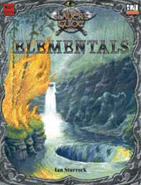
|
About OgreCave and its staff
|

|
by Joe G. Kushner
I have a love-hate relationship with Mongoose Publishing. Many of their products boast top notch ideas but are marred down by editing and game mechanics. This book shares some of those traits but manages to rise above the average Slayer's Guide with its increased size and focus on new creatures. Some of these are old favorites including quasi-elementals like mineral and radiance, while others add new size categories to the game including fine, diminutive and tiny elementals. Those that don't fall into those two broad categories of quasi- or new size, tend to be animal like. For example, the wave eagles use tsunamis; and the Ushkya is a water horse. The variety of creatures is good. The issues with the game mechanics don't happen with every creature and if you're not looking for it, it'll be easy to miss. That water horse for example, has 5d8 hit dice, but only a +2 to it's base attack. The lesser phoenix on the previous page, has 4d8 hit dice, and a +3 to it's base attack. One of those numbers is wrong. Other issues will be caught by the keen eye, but in a volume with so many creatures, it's seems sadly unavoidable. Mongoose drew from several different real world mythologies and provides statistics for the elementals mentioned in each. For example, the book's brief look at elemental lore mentions the Chinese Elements of Metal and Wood, and so we have six standard (small, medium, large, huge, greater, elder) versions of those creatures. Another creature drawn at least partly from mythology is the earth jaguar, a massive stone cat that roams the elemental plane of earth and the astral plane, inspired by Aztec myths. One thing I don't like about the book is that it takes twice the space for creature listings as the standard Monster Manual. This book uses two pages to detail out its six standard elementals while the Monster Manual uses one. Another problem is not every creature is illustrated, nor given description. On the positive side, there is combat advice for running them, similar to the combat tactics that the Monster Manual introduced for a few of its creatures. If Mongoose could've controlled the size of the entries and kept them a more standard size, there would've been more room for background information, other notes, and illustrations. The art also varies in taste. I know that some people love cheesecake art, and when it's appropriate, like in the Slayer's Guide to Amazons, I don't mind. But here, when there are so many elemental forces not illustrated, do we need it? Most of the art is good stuff though, including the cheesecake elements, done by Patricio Soler. My personal favorite is the front interior cover that shows the four elemental forces opposite one another in full color with brief notes: "Earth: Extremely strong and tough. Very large stone humanoid. Two eyes that sparkled like gems. Voice sounds like a deep tunnel." Where some Slayer's Guides might provide details of an encampment with a variety of foes to encounter, this Guide goes another route by giving some basic information on the various planes. This information is a who's who of each plane but doesn't go into any third party support, relying instead on the core Monster Manual elements that are OGC, as well as those in this book. Under the elemental plane of water, a paragraph for background is given, and then three entries, for undine, water elementals, and wave eagles respectively, are provided to show what these creatures do on their native planes. At a few sentences, it's not much.
Conclusions The Slayer's Guide to Elementals is good for those looking for more monsters for their campaigns. But for those looking for details of history, society, maps, or lairs, the Slayer's Guide to Elementals doesn't provide adequate coverage.
|
||
 The Slayer's Guide to Elementals
The Slayer's Guide to Elementals